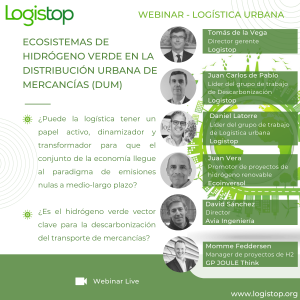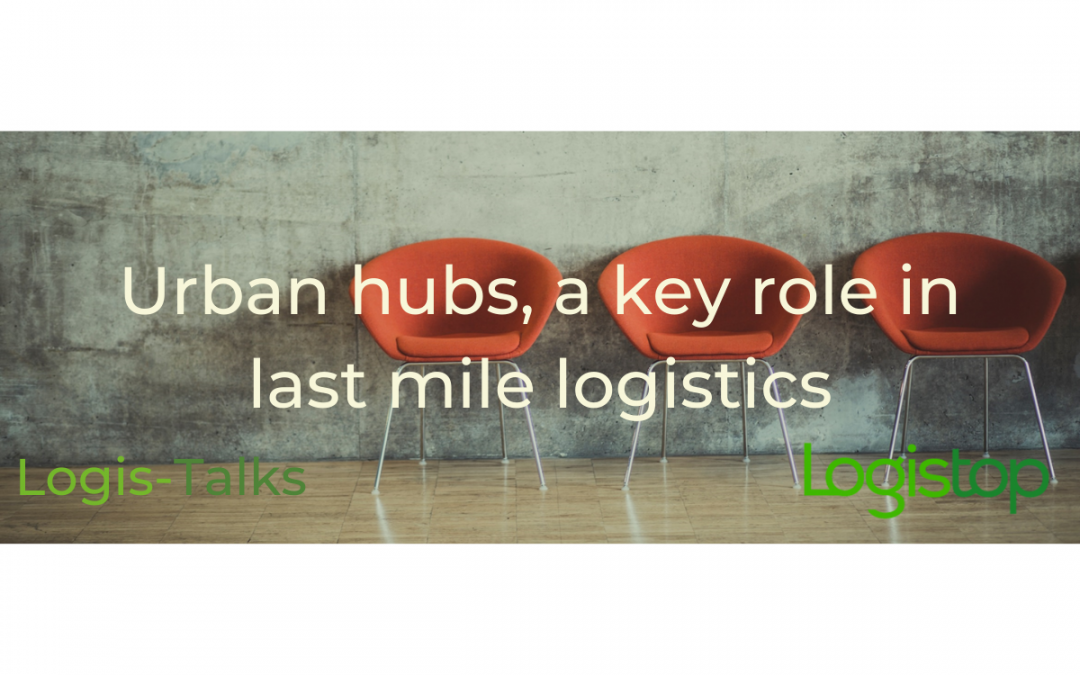- Microfulfillment and nanofulfillment, present in urban hubs.
- Logistics is an essential factor in creating sustainable and green cities.
- Changing consumer trends and habits are changing the paradigm, with immediacy and sustainability taking precedence.
In Logis-Talks “Automation of urban hubs: present and future” we analysed and discussed the challenges and solutions presented by the automation of urban hubs, both in the short and medium and long term, at a time when the future of logistics, increasingly more present and less future, involves adapting to the new demands and restrictions, among other aspects, that are occurring in a context increasingly focused on automation, sustainability and efficiency.
To analyse these issues, we had the participation of César Fernández – Pacheco, Technical Director at Expertia, Diego Zúñiga García-Falces, CEO at Ubyko, Juan Vicente Sanchís, CEO at Vcon, and Hendrik Thamer, CEO at Cellumation, as well as the presentation and moderation of Tomás de la Vega, Managing Director at Logistop.

Strategic vision: actions and concepts related to the automation of Urban Hubs
César Fernández-Pacheco, in his speech, provided us with an overview of the models involved in everything related to urban hubs. To this end, he considers it necessary to structure the hubs into three different groups according to the technologies available. In this sense, we would have a first group in which the goods are previously separated by routes, or easily separable and only need to be transferred to urban distributors.
Secondly, we would have an urban hub model with consolidated goods by reference that need to be separated into routes or orders in which there are many sorting technologies and innovations that are being produced, offering both high-speed and medium-speed solutions, as well as low-speed ones. In the latter case, César highlights the high-density solutions available, a concept that is exploding especially in the urban and peri-urban world with a rapid evolution in recent years.
And thirdly, we are faced with a type of urban hub where delivery is not cross docking and stocking and warehousing is required, leading to microfulfillment systems (preferably in a peri-urban environment) or nanofulfillment systems in urban environments.)
“Depending on the technologies we have available thanks to the evolution that has been taking place in recent years, we can structure urban hubs into three types: 1) with goods previously separated by routes, or easily separable; 2) with consolidated goods by reference that need to be separated into routes or orders; and 3) the delivery is not cross docking and stocking is required.”
César Fernández – Pacheco, Technical Director, Expertia
Capillarity and automation, the new last mile logistics
Next, Diego Zúñiga García-Falces reviews the evolution that mobility has experienced throughout recent history, where it is going and how a solution such as the one available at Ubyko can help to solve the problems that mobility presents today.
The change that has taken place in consumer habits and trends, the universalisation of digitalisation, as well as the elimination of the existing barrier to the insecurity of online payment, has produced, as Diego points out, a double change in the paradigm. On the one hand, consumers’ demand for immediacy and, on the other, a new pedestrian and sustainable city model, which makes traditional logistics impossible. This is causing last-mile logistics to be reset, relying on predictive capacity, capillarity and automation.
This update of the last mile should lead to a system that will allow us to have certainty in delivery, resulting in a successful delivery and immediate customer enjoyment, as well as the use of more sustainable and faster vehicles.
To conclude his speech, Diego explained how the solution developed by Ubyko is a fully automatic nanofulfillment with connection to the street through an ATM and the possibility of having a digital shop window. Given the times of uncertainty about the future in general, and the last mile in particular, the hardware is designed in a modular, open and flexible way to be able to transform, grow or adapt over time to future needs or changes in the strategy of the companies. Click&Collect, stocking and marketing solutions are united in a single point. A mixed system with which to achieve both commercial and logistical omnichannel. A tool with which, thanks to automation, ultra-fast delivery times can be achieved 24 hours a day, and with the cost savings that a fully automatic node entails.
“We are facing the clash of a double paradigm shift. On the one hand, consumers’ demand for immediacy and, on the other, a new pedestrian and sustainable city model, which makes traditional logistics impossible. This is causing last-mile logistics to be reset, relying on predictive capacity, capillarity and automation.”
Diego Zúñiga García-Falces, CEO, Ubyko
Last mile automation – case study
For his part, Juan Vicente Sanchís detailed how, working in collaboration between Vcon and Cellumation, starting with a football robot from the CM Dragons team, they have been working on the development of the celluveyor cell and have been able to develop different applications and an important Knowhow that has allowed them to reach different sectors, as well as develop a business model focused on the last mile through the automation of the microhub in cities (logistis-as-a-service).
“Apart from reviewing the operational processes as such, we have to be very attentive to any changes in trends and, based on these, we must review the processes and apply the measures that will allow us to improve them in a more efficient way and adapted to the needs.”
Juan Vicente Sanchís, CEO, Vcon
In this sense, Hendrik Thamer presented the pilot project they are developing in the German city of Göttingen. To reach this point, they have taken into consideration the change in consumer behaviour and mobility habits, taking into account that more than 50% of distribution costs are generated in the last mile.
Until now, the last mile was characterised by stakeholder dissatisfaction, where cities had high traffic and emission burdens, poor accessibility to delivery destinations and failed attempts, as well as the fact that the local economy was not integrated into this system.
However, with the proposal presented, Hendrik analyses how they are able to consolidate the Logistics-as-a-service business model characterised by the strategic and geographical location of the Hubs in the cities, the integration of local trade into the distribution network, as well as the possibility to offer an efficient and green (CO2-free) local delivery service, among others.
“The pilot in the German city of Göttingen is proof that sustainable logistics is possible. All that is needed is a city that will take the plunge.”
Hendrik Thamer, CEO, Cellumation
About Logistop
Logistop is the benchmark workspace for collective innovation through the realisation of projects hand in hand with our members. Transforming the entire supply chain into a more efficient and sustainable one. All this with the aim of articulating and carrying out innovation projects among the members, without excluding the possibility of collaborating with or receiving support from certain organisations outside Logistop.

